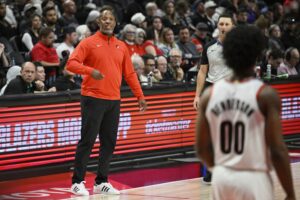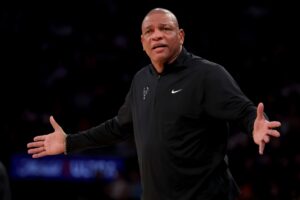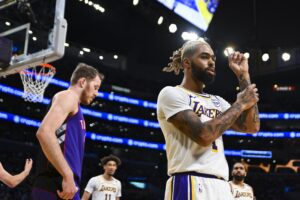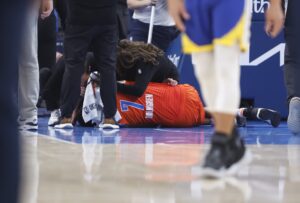The Cavaliers and Lakers are in different conferences but share the same problem. They are both looking to compete for a meaningful shot at an NBA championship. Both teams feel they are closer to contending rather than rebuilding. They each have new coaches and are figuring out ways to improve their rosters, either through their core players or along the margins. This trade sees the Cavaliers and Lakers solving key issues that will make them take one step closer to achieving their goals.
This Trade Sees the Cavaliers and Lakers Solve Key Issues
Six-Player Deal Along With Draft Picks
The season is less than two months away, and the last time the Lakers made meaningful additions to their roster was back in June through the draft. When they added Dalton Knecht and Bronny James, Lakers fans hoped those would be the first moves on the chessboard by Rob Pelinka. In an unexpected turn of events, they have been watchers rather than movers in the NBA landscape.
The Cavaliers are another team trying to break patterns. They have flirted with the idea of trading one of their current four core players. Seeking change, they decided to fire J.B. Bickerstaff and hire Kenny Atkinson instead. Fans, analysts, and media members mostly feel this group of players has reached its ceiling together. Sometimes, the grass is greener on the other side, and a trade between the Cavaliers and Lakers could demonstrate this.
Trade Details:
Cavaliers get: Rui Hachimura, Jalen Hood-Schifino, Jaxson Hayes, a 2025 second-round pick via the Clippers, and a 2027 second-round pick.
Lakers get: Caris LeVert and Dean Wade
Why Would the Cavaliers Do This Deal?
This deal helps the Cavaliers in a multitude of ways. First, they will get a starting-level power forward who can space the floor and play good to great defense depending on the matchup in Hachimura. Currently, at the power forward position, they have Evan Mobley, Georges Niang, and Wade.
Mobley is an elite defender, but his fit alongside Jarrett Allen is clunky at best. While he shot the three-ball at a career-best 37.3%, it was on a very small sample size of 1.2 attempts per game. Defenders don’t respect his shot enough for him to space the floor.
Niang has always shot the ball at an elite clip (39.7%) for his career, but he’s not a starter. He has started only 29 games in his eight-year career. Wade is an effective three-and-D wing, but he’s also not a starting-caliber four. While he started 32 games last season, it was often in the absence of Mobley. He averaged only 5.4 points per game.
Hachimura is a starting power forward who can space the floor. He shot a career-best 42.2% from beyond the arc on 3.4 attempts per game and averaged 13.6 points per game on a 60.9% effective field goal percentage. At six-foot-seven with a wingspan of seven-foot-two, he has all the tools to be a great post and paint defender. He had a rim defense score of -2.8, which is in the 64th percentile— a very effective number for a wing. Hachimura also has a defensive versatility rating of 69, in the 69th percentile in the NBA.
Other Components
Hood-Schifino is a tantalizing prospect for the Cavaliers, a team that is devoid of first-round picks until 2030. Outside of Jaylon Tyson, whom they drafted this year, they don’t have any player 22 or younger on their roster. Hood-Schifino is a 21-year-old six-foot-six combo guard who feasts in the mid-range and thrives in half-court offenses. He’s essentially a younger LeVert, so they get some return for LeVert, who could walk for nothing when he becomes an unrestricted free agent next summer.
Hayes won’t be expected to play much in this rotation. Still, this is a team with six open roster spots and a need for a backup true center. The second-round picks are just compensation to oil the deal.
Why Would the Lakers Do This Deal?
The Lakers are motivated to do this deal because they get rotation players in exchange for a starter. Wade, as explained earlier, is an excellent spacer, ideal beside LeBron James and Anthony Davis. His ability to play with any set of teammates is rated in the 89th percentile in the NBA. Wade is also an extremely good defender. His deflections rank in the 73rd percentile, and he has a rim defensive score of -4.7. Wade blocks 2% of the shots he faces, which is in the 65th percentile in the NBA. Remember, he’s a six-foot-nine wing. His defensive plus-minus of 2.5 is in the 97th percentile. He’s the quintessential three-and-D wing.
LeVert gives the Lakers size in the guard position. At six-foot-six tall with a wingspan of six-foot-10, he’s an effective on-ball stopper on defense and a solid shot creator on offense. He averaged 14.0 points primarily off the bench (10 starts). He is an inconsistent shooter from three-point range, but he makes up for that with his shot creation. LeVert ranks in the 85th percentile in that category. Defensively, he gives the Lakers a point-of-attack defender at the guard position. His 2.7 deflections are in the 76th percentile in the NBA, and his rim defense score of -8.6 is in the 90th percentile. LeVert’s defensive versatility is in the 76th percentile in the NBA.
A critical added bonus is that the Lakers don’t lose any of their first-round picks in this deal. They can still dangle the contracts of D’Angelo Russell, Gabe Vincent, and Jarred Vanderbilt if they want to make other moves.
The Last Word
The Lakers were middle-of-the-pack (17th) in defensive rating (114.8) last year. Adding LeVert and Wade elevates their defense. The shot-making and three-point shooting from these two offset the loss of a starting-caliber four for the Lakers.
The Cavaliers get a power forward they can slot alongside Mobley or Jarrett Allen in traditional one-big lineups. They can use him in their two-big lineups at the small forward position if they want to prioritize defense and shot creation while not sacrificing spacing at the three. This deal is a win-win scenario. The trade sees the Cavaliers and Lakers fixing roster issues.






